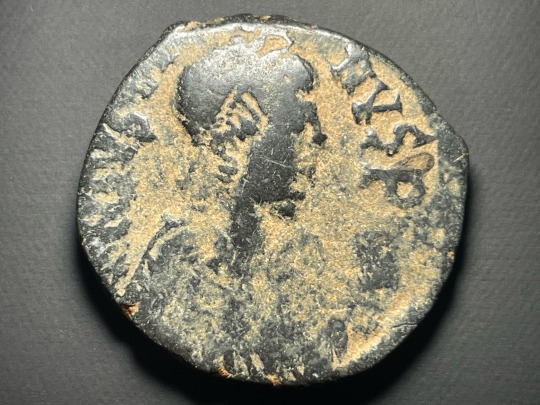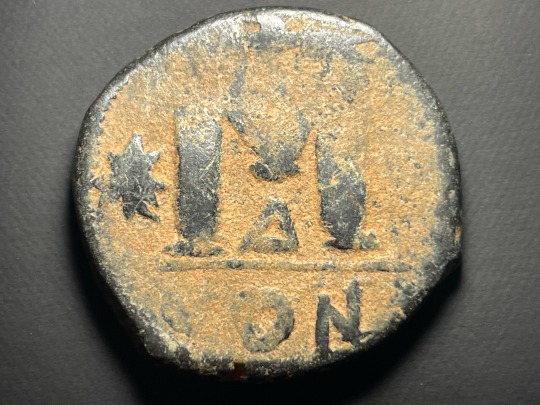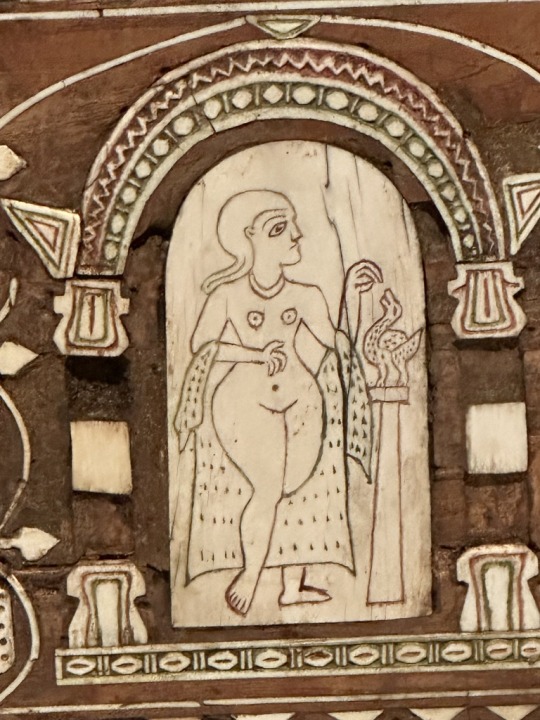#byzantine coins
Explore tagged Tumblr posts
Text
Coin of the Day #16 (5/20/2024)
Justin just in time for the new week.


Byzantine Empire
AE Follis - 29mm 15.64g
Justin I 518-527 AD
Constantinople Mint
Obverse D N IVSTINVS P P AVG
Bust of Justin I right, diademed, draped, cuirassed
Reverse Large M between star and cross, cross above, Δ below, CON mint
SB 63
#coin of the day#byzantine empire#Justin I#byzantine#byzantine coins#coin#coins#numismatics#ancient coins
7 notes
·
View notes
Text
#medieval coins#ancient currency#historical coins#Middle Ages coins#medieval numismatics#medieval silver coins#medieval gold coins#medieval copper coins#medieval coinage#medieval mints#medieval economy#medieval trade#ancient coins#coin collecting#medieval artifacts#medieval currency#medieval money#feudal coins#medieval kings#medieval monarchs#medieval Europe coins#medieval Islamic coins#Byzantine coins#medieval treasures#medieval coin hoard#medieval coin finds.
1 note
·
View note
Text
Christian Reliquary Cross Found in 11th Century Byzantine Fortress in Southeast Bulgaria Destroyed by Crusaders in Third Crusade
The newly discovered engolpion (reliquary) medieval Christian cross from the Small Fortress near Bulgaria’s Voden. Photo: Yambol Regional Museum of History A bronze reliquary cross from the High Middle Ages of the engolpion type – i.e. a hollow cross used for keeping holy Christian relics – has been discovered by Bulgarian archaeologists during the excavations of the “Small Kale,” a fortress near…
#Asen and Petar&039;s Uprising#Bolyarovo Municipality#Bulgaria-Turkey border#burial#burial chamber#Byzantine aristocracy#Byzantine coins#Byzantine Empire#Byzantine yoke#Byzantium#chapel#Christianity#coin#coins#Comnenus Dynasty#Constantinople#cross#crossguard#crusaders#crypt#Diana Stoyanova#Eastern Roman Empire#engolpion#excavations#First Bulgarian Empire#fortress#fortress gate#fortress wall#fortress walls#High Middle Ages
0 notes
Text


~ Solidus with Licinia Eudoxia.
Period: Byzantine, Reign of Valentinian III
Date: A.D. 439
Mint: Ravenna
Medium: Gold
#ancient#ancient art#history#museum#archeology#ancient history#archaeology#coin#ancient currency#ancient coin#money#solidus#Licinia Eudoxia#Valentinian III#Byzantine#Byzantium#gold#Ravenna
957 notes
·
View notes
Text












The Metropolitan Museum of Art, Africa and Byzantium
#art#art history#archaeology#academia#anthropology#museum#medieval art#ancient#ancient art#byzantine art#the metropolitan museum of art#africa and byzantium#africa#coins#textiles#painting
32 notes
·
View notes
Text

Archaeologists Find Gold Coins From The Time of Justinian the Great in Bulgaria
Archaeologists have discovered five gold coins dating from the reign of Justinian the Great (483-565) in Debnevo, the largest village in the Troyan Municipality in northern Bulgaria.
Justinian was a powerful emperor, who reconquered previously owned Roman land. During his time of reign, he helped the Byzantine Empire reach its peak in culture and prosperity. From 527 until 565, Justinian I ruled as the Byzantine Empire’s emperor. Justinian is best remembered for his work as a legislator and codified.
The discovery was announced on 27 August by Assoc. Dr. Stiliyan Ivanov from the National Historical Institute with a museum at the Bulgarian Academy of Sciences, who led the archaeological expedition exploring the fortress “Kaleto” above the village.
Archaeologists exploring the Kaleto Fortress above the village found the coins scattered on the floor of a burned-out dwelling dating to the time of the reign of the Bulgarian kings Simeon and Peter.
“During this year, the most interesting archaeological situation is an early medieval dwelling that was burned down. In other cases similar dwellings are found without remains of the internal structure, while here we have the rare opportunity to see the wooden lining of the dwelling, which, although charred, is clearly discernible. It must be related somewhere to the 10th century, to the time of the rule of the Bulgarian kings Simeon and Peter”, the associate professor said.


The owners left all the inventory in the dwelling – two iron sickles, iron tools, a belt buckle, three bronze rings, various-sized ceramic vessels, from which it can be judged that they were involved in agriculture, he added.
“The most interesting find from the apartment is the discovery of five gold coins scattered on the floor. Two of them were badly damaged by fire. What is interesting about the coins is that they are much older than the early medieval dwelling where they were found. They date from the 6th century, from the time of Emperor Justinian I. They were most likely discovered by those who built the dwelling and who subsequently preserved them”, said Ivanov.
Although not in circulation, these coins were valuable enough because they were made of gold – a material that was quite valuable even in the Middle Ages”, Dr. Ivanov said.
According to Ivanov, part of the fortress walls are well preserved, while others have suffered because material from them was used to construct a nearby settlement. He said that traces are found of a large Thracian settlement from the 4th-3rd centuries BC, three phases of habitation from Late Antiquity (4th-6th centuries), the First Bulgarian Kingdom, a necropolis from the Second Bulgarian Kingdom and the Ottoman period.
By Oguz Kayra.

#Archaeologists Find Gold Coins From The Time of Justinian the Great in Bulgaria#Debnevo#Byzantine Empire#gold#gold coins#collectable coins#ancient artifacts#archeology#archeolgst#history#history news#ancient history#ancient culture#ancient civilizations
27 notes
·
View notes
Text

Stash of Byzantine era coins discovered in the Golan Heights (Syria), circa 635 AD
110 notes
·
View notes
Text

Coin/ Gold Solidus. Byzantine. 610-641 CE.
The Wadsworth Atheneum Museum of Art.
#art#culture#currency#economics#economic history#ancient coins#byzantines#byzantine art#byzantine empire#ancient history#middle ages#medieval history#the Wadsworth Atheneum museum of art
3 notes
·
View notes
Text

Byzantine Solidus of Theodosius II (402-450). Weight 4.48 g, between 416-418, minted in Constantinople (CONOB) . Scripted: D N THEODO - SIVS P F AVG. Pearl-diademed bust, wearing consular robes and loros, holding mappa in right hand and cruciger scepter over left shoulder. / SECVRITAS RE - IPVBLICAE. Theodosius, dressed in consular robes, seated facing on curule chair, mappa in right hand, cruciger scepter in left; in left field, star ⭐️. #archaeology #history #ancient #art #archaeologist #ancienthistory #travel #archaeological #rome #italy #museum #roma #heritage #byzantinetoman#arthistory #archaeologylife #culture #antiquity #medallion #photography #Solidus #Theodosius_II #byzantinecoin #byzantinearcheology #byzantinecoins #الصديق_الصدوق
#theodosius#history#archaeology#photography#culture#roman coins#sidon saida tyre beirut phoenician الصديق_الصدوق#Byzantine
3 notes
·
View notes
Text

Solidus (Coin) of Tiberius II
Byzantine, 574–582
Coins were an ideal way for Byzantine emperors to circulate their images throughout the empire and beyond, since they were used to pay for imported merchandise and to pay foreign mercenaries. They could also be employed as powerful vehicles for propaganda, promoting dynastic succession and emphasizing the earthly emperor’s god-given right to rule. Tiberius had an image of a monumental cross in Jerusalem placed on the back of his coin. This coin is a gold solidi weighing 4.5 grams. From the fourth century on, the solidus was the preferred gold coin issued by Byzantine emperors. The solidus remained essentially unaltered in weight and purity until the tenth century.
14 notes
·
View notes
Text
youtube
A Hoard of 44 Byzantine Gold Coins Was Discovered in Israel
from the Israeli Antiquities Authority
50 notes
·
View notes
Text
Coin of the Day #188 (11/8/2024)
A year 1 Heraclius half follis…


Byzantine Empire
AE Half Follis - 23mm 5.47g
Heraclius 610-611 AD
Constantinople Mint
Obverse D N hRACLI PERP AVI
Bust of Heraclius front, wearing crown, holding globus cruciger and shield
Reverse Large K
ANNO left, I right, cross above, Δ below
SB 813
#coin of the day#byzantine empire#heraclius#constantinople#byzantine coins#coin#coins#numismatics#ancient coins
2 notes
·
View notes
Text
Solidus Coin of Emperor Theophilos(829-842)

Emperor Theophilos was Byzantine Empire during the Second Iconoclasm before the victory of Orthodoxy which would settle all question on the issues of using images to represent Christians.
#eastern roman empire#roman emperor#coins#roman empire#ancient coins#byzantine empire#coinage#christians
1 note
·
View note
Text
Intriguing ‘Dionysus with Panther’ Chariot Applique Discovered in Bulgaria’s Skutare in Settlement Inhabited in Ten Different Periods
A likely chariot bronze applique showing ancient deity Dionysus with a panther (leopard) has been discovered at the prehistoric, Antiquity, and medieval settlement at Bulgaria’s Skutare near Plovdiv. Photo by lead archaeologist Elena Bozhinova, Plovdiv Museum of Archaeology A highly intriguing ancient artifact – a bronze applique depicting wine god Dionysus together with what is believed to be a…
#Ancient Rome#Ancient Thrace#Ancient Thracians#Antiquity#applique#appliques#Archaic Period#Bronze Age#bronze applique#Bulgarian Archaeology exhibition#Byzantine Empire#Byzantium#Chalcolithic#chariot#chariot applique#Classical Period#coin#coins#Copper Age#Dionysus#Early Iron Age#Early Middle Ages#Eastern Roman Empire#Elena Bozhinova#excavations#Iron Age#Late Bronze Age#leopard#Middle Ages#Middle Bronze Age
0 notes
Text
I need to start dating I cant stop bidding on coins on eBay
1 note
·
View note
Text

Gold solidus bearing Mauritius Tiberius. minted in Constantinople
1 note
·
View note